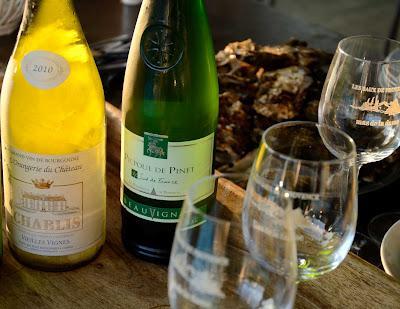
 This morning, the collection included a Muscadet, a Picpoul and a Chablis from our oyster wine-match experiment. Then, of course there was the Tavel - a palate cleanser before the main, then the rest of the whites with it. I think the "Vallon" from Mas de la Dame probably got popped about 10pm. God knows who opened the Loupiac - it wasn't me, although I do remember enjoying a little of it. Oh, I forgot we also had some aperitifs - a half bottle of Pastis 51 got finished by the pool with a bowl of olives, and someone was obviously drinking Heineken. There's another empty red - some non-descript vin de pays that was grappled in drunkenness after I'd staggered up to bed, no doubt. This morning the glass is scattered around the overflowing recycling bag like bones from a picked carcass. Flies hover, drawn by the putrid smell of over-ripe grapes and sticky dregs. To me, it smells like death. Never again...
This morning, the collection included a Muscadet, a Picpoul and a Chablis from our oyster wine-match experiment. Then, of course there was the Tavel - a palate cleanser before the main, then the rest of the whites with it. I think the "Vallon" from Mas de la Dame probably got popped about 10pm. God knows who opened the Loupiac - it wasn't me, although I do remember enjoying a little of it. Oh, I forgot we also had some aperitifs - a half bottle of Pastis 51 got finished by the pool with a bowl of olives, and someone was obviously drinking Heineken. There's another empty red - some non-descript vin de pays that was grappled in drunkenness after I'd staggered up to bed, no doubt. This morning the glass is scattered around the overflowing recycling bag like bones from a picked carcass. Flies hover, drawn by the putrid smell of over-ripe grapes and sticky dregs. To me, it smells like death. Never again...I feel like someone has been practicing gavage on me. I'm sure, that if you ran a liver function test right now, I just might break the graph. It's not just the booze. The oysters last night were so fresh they quivered away from the lemon juice. They were followed by bread. And butter, lots and lots of butter with coarse grains of salt that explode on the tongue as it melts. Saucisson - the devil itself wrapped up in a mouldy skin, bloody and fat-speckled, feral, dry and stringy. Lamb - agneau, slow cooked and glutinous, dripping and delicious. Fromage - quel dommage. Cheese that oozes and slides down your throat like viscous seasoned velveteen. Caramel, in nougat, in ice-cream or in its pure tacky form, so sweet it prickles your throat and cloys into the next day. And then of course the piece de resistance - foie gras - served with a softly sweet wine with zingy acid to bring out the richness and creaminess of the treat.
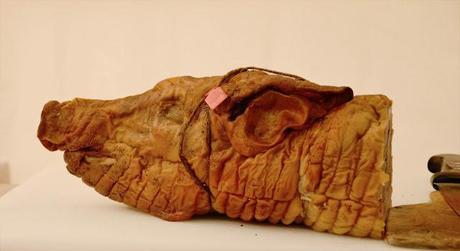
Foie gras translates directly as "fat liver". There's more than one kind available in France, so fortunately me and my enlarged and pale desperate organ may spare slaughter for a little while. There's quite a bit of press surrounding it at present, but it's hardly a modern invention. Gavage, or the method of force feeding birds with an oesophageal tube, has been going on for 2500 years. History in a sentence - the Egyptians discovered it, the Romans and Hebrews exported it, the French mastered it, and then the Californians banned it.
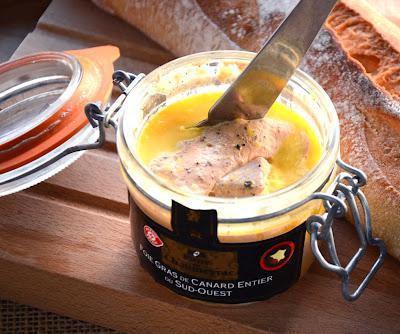 It's not at all ironic it's been banned in California, a state famous for colonic irrigation and the detox diet, a place where any fat liver is considered improper. Nor is it a first - the practice (although often not the purchase) of foie gras production is banned in many countries. Yet, for some reason, it's caused a little hoo-ha, and rebounded the topic around the world the way propaganda usually does. So again, we are force-fed images of bedraggled geese in tiny pens, bleeding from beaks and bottoms, vomiting corn and all in all having an incredibly inhumane life. But the news is not new - the practice is well practiced, widely practiced, and continues to be practiced. And the story will always end the same way, with the product either on the plate or off. This will depend on the individual's knowledge, or desire for knowledge on the subject, and which way the hart strings pull.
It's not at all ironic it's been banned in California, a state famous for colonic irrigation and the detox diet, a place where any fat liver is considered improper. Nor is it a first - the practice (although often not the purchase) of foie gras production is banned in many countries. Yet, for some reason, it's caused a little hoo-ha, and rebounded the topic around the world the way propaganda usually does. So again, we are force-fed images of bedraggled geese in tiny pens, bleeding from beaks and bottoms, vomiting corn and all in all having an incredibly inhumane life. But the news is not new - the practice is well practiced, widely practiced, and continues to be practiced. And the story will always end the same way, with the product either on the plate or off. This will depend on the individual's knowledge, or desire for knowledge on the subject, and which way the hart strings pull.Basically, the way it works is this:
A duckling, or gosling, starts its life in fairly normal fashion, except that it has probably been hatched under a lamp rather than a cozy feathery bottom. It will wander around in a free-range area, or a communal pen until it gets to full size. Then it will be removed to either a different pen, or a solitary cage, where it will remain fairly much unimpeded except for 15-20 seconds, two to three times a day, whereby it will have a tube inserted into its throat and partially into its oesophagus, and have a fairly copious amount of grain delivered. This will go on for anywhere between 2-5 weeks, depending on the size of the bird. Over this time, the liver will become enlarged, and will end up comprising up to 10% of the body weight of the bird, and be up to 10 times the liver's normal size. The bird is then slaughtered, after a short life - as little as 10 weeks. The entire bird is used - not just the liver.
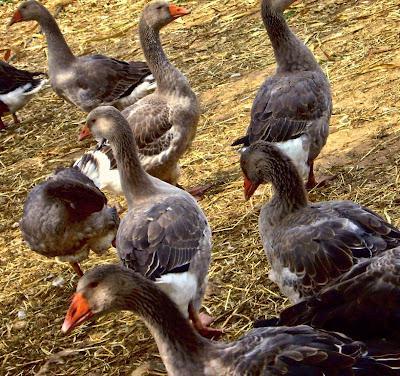 The producers will point out that the selected breeds of migratory bird have no gag reflex, and that the tube does not hurt as it would in humans (true - this is why chickens are not used - they have a gag reflex and the process would not work). They will also remind us that birds will naturally gorge themselves (incidentally, the french word for throat is gorge) before migrating for winter. This is also true, and in fact, the reason it was initially discovered in Egypt that the liver tasted better when it was fatty. Is is also still evident in the wild, proven by hunters of wild birds, who will often come across birds with naturally engorged livers. They will also remind us that foie gras is simply much better for cooking - it looks better - creamy pale, is finer textured, and of course is richer, softer, fattier, and bigger than standard livers.
The producers will point out that the selected breeds of migratory bird have no gag reflex, and that the tube does not hurt as it would in humans (true - this is why chickens are not used - they have a gag reflex and the process would not work). They will also remind us that birds will naturally gorge themselves (incidentally, the french word for throat is gorge) before migrating for winter. This is also true, and in fact, the reason it was initially discovered in Egypt that the liver tasted better when it was fatty. Is is also still evident in the wild, proven by hunters of wild birds, who will often come across birds with naturally engorged livers. They will also remind us that foie gras is simply much better for cooking - it looks better - creamy pale, is finer textured, and of course is richer, softer, fattier, and bigger than standard livers.Animal welfare supporters will argue the following very valid points.
- It's just not nice. How would you like to be fed that way?
- The feeding of birds in this way has effects besides simply enlarging the liver. Anyone who is overweight can tell you life is less comfortable than when they are lean. In some farms, it has been found that the practice has caused severe damage to the birds, beyond even this. (see the PETA site)
- Birds are horribly confined and kept in unclean environments. (yes, this does happen, but not at every single farm)
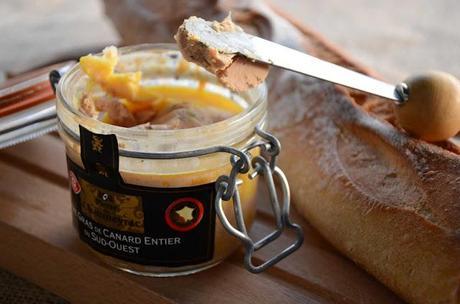
Maybe I should add my own two cents. Don't kid yourself that if you just stop eating foie gras, that you are protecting animals from poor treatment. Ducks and geese farmed for foie gras are not necessarily treated worse that ducks and geese farmed specifically for their meat. In fact, apart from the feeding and the general feeling of being overweight, they may well have a better life. A duck farmed for meat can quite likely have a 7-week lifespan in a single cage. And we all know about battery hens. Essentially, it all comes down to the farm, and the way the owners want to treat their animals - there are some good, and some bad - just like in any industry. Grain-fed beef, people? If you eat any meat from a farm at all, you are probably condoning some form of animal cruelty - even free range chickens. So unless you are hunting your own food or vegan, it's probably best not to get on your high horse about foie gras.
So, as you can see, I'm not entirely against fat liver. I'd prefer not to have one myself, but as with the kind I can purchase, it will require some restraint if I want to avoid it. Not really my strong point, I'm afraid. Santé...
--------------------------
For those who like to sit on the fence, maybe look for some ethical foie gras. It's kind of free range - the geese or ducks are free to roam on a farm, and are hand fed full grains twice daily. There are French, Spanish and produced ethical foie gras, but they take a little searching. Some of the US farms are also very happy to allow visitors to prove that their farms are not bad-eggs. If you want to avoid it all together, but feel like you might be missing out, maybe you might want to try some faux gras...? As with all food, if you care about what you put into your body, and how it affects the world around you, it's best to research, research, research. But you might want to do a taste test too...
